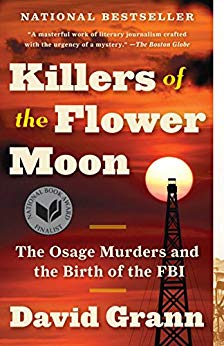

This article is an excerpt from the Shortform summary of "Killers of the Flower Moon" by David Grann. Shortform has the world's best summaries of books you should be reading.
Like this article? Sign up for a free trial here .
What happened during the Osage murder trial? Were the killers and conspirators ever brought to justice?
Investigator Tom White faced several hurdles during the Osage murder trials. He battled witness tampering and the political dealings of the main conspirator, William Hale.
Keep reading to learn how, in the end, White secured convictions for Hale and others during the Osage murder trials.
The Prelude to the Murder Trials: Confessions & Charges
With Burkhart and Ramsey’s confessions in the books, FBI agent Tom White decided that it was time to talk to Hale and continue building a case for a murder trial. And while White’s agents couldn’t conclusively link Hale to all 24 Osage murders from 1921-1926, they could at least prove that he had benefited financially from many of them, including that of George Bigheart. But the calm and confident Hale was entirely unperturbed by the mounting evidence against him and refused to yield anything to the investigators. He simply told them that he was prepared to have his day in court and fight the charges.
The national press covered the murders and the ensuing trial with a grisly fascination, often treating it as an entertaining spectacle, rather than as a tragedy defined by the exploitation and grief of a long-suffering and persecuted people. For their part, the Osage simply wanted to see justice done and do everything in their power to ensure that Hale’s powerful influence wouldn’t tamper with the trial.
But this was a tall order. The Oklahoma state judicial system was wracked with corruption, with judges and prosecutors widely known to take bribes from wealthy defendants. A man like William Hale would easily be able to manipulate the system. White understood that his murder trial was dead if he had to take it to state court. His only chance of securing a conviction was to take the case into federal court.
But because most of the surface land allotted to the Osage had already been sold to whites (the Osage retained the oil and minerals underneath), most of these murders had thus taken place on land that was under Oklahoma’s jurisdiction. There was one exception, however: the murder of Henry Roan, whose body had been discovered on Osage-controlled territory, and, theoretically, eligible for federal prosecution. This was the case they decided to bring Hale up on, hoping that this murder trial was the one most likely to result in a conviction. But here, White and his team suffered another setback when a U.S. district court judge ruled, on technical grounds, that the Roan case had to be tried in state court.
Fortunately, White had also worked with the Oklahoma state attorney general to draft murder charges on the Smith bombing for use in state court, in the event that the federal government was found to be lacking jurisdiction. Hale and Ramsey were immediately re-arrested and put on trial for the murder of Bill and Rita Smith. Still, the trial would now be held in Hale’s domain of Osage County, presenting the prosecution with a steep uphill battle. The government assembled an all-star legal team for the prosecution, while Hale hired his own team of high-powered attorneys, which he was confident would help him defeat the charges.
The Trial of Ernest Burkhart
What happens in a murder trial? In this case of the Osage murder trials, they were stalled by backroom dealings and witness tampering. The murder trial was devastating for Mollie Burkhart, as she learned more about the plot to eliminate her family. The national press, which avidly covered the case, refused to respect her privacy, circulating photos of her around the country and generally portraying her as an ignorant, backwoods Osage. Hale, meanwhile, packed the gallery with his supporters, who would hoot and cheer at every motion made by the defense and jeer and boo the prosecution. It brought a circus-like atmosphere to the trial and amply demonstrated the difficulties of bringing a white man to justice for crimes against an Osage Indian.
During the murder trial, Hale’s team lied and blatantly tampered with the witness Ernest Burkhart and attempted to intimidate him into silence. Shockingly, the judge allowed all of this to happen in open court. On one occasion, Hale openly berated Burkhart personally, in full view of the judge and jury. White was outraged and appalled by the utter brazenness and arrogance of Hale’s conduct.
Now, under the pressure of Hale’s backroom scheming, Ernest recanted his testimony, claiming that he knew nothing about the murders and taking the stand as a witness for the defense instead of the prosecution. Outrageously, he claimed that White’s agents had only obtained his confession through torture—a lie that was echoed by Hale and Ramsey. White’s onetime star witness was being used against him.
To bolster their position against Hale, the prosecution decided to first seek a conviction of Ernest Burkhart. With Ernest recanting, however, their case looked like it was falling apart. But the prosecution had one more card to play: Kelsie Morrison, the notorious bootlegger, outlaw, onetime Bureau informant, and the man whom Ernest had fingered as Anna Brown’s killer. The prosecutor brought Morrison in to take the stand. This time, Morrison decided to cooperate with the government against his former employer, Hale. Though confessions in court are not always part of what happens in a murder trial, Morrison confessed in open court that he had been recruited by Hale to help eliminate Mollie’s entire family. He then proceeded to narrate the awful details of Anna’s final moments.
He and Bryan Burkhart had gotten Anna drunk at a speakeasy before driving her out to Three Mile Creek. Bryan’s wife, Cole (who corroborated all the details of Morrison’s testimony) waited in the parked car to stand lookout. They then dragged the inebriated Anna down into the ravine. Bryan propped her up on a rock and held her still while Morrison shot her in the back of the head—with a gun that had been provided by Hale.
Ernest Burkhart could now see the tide turning in the case. On June 9, 1926, he notified the prosecutors that he wished to change his plea again, this time to “guilty.” He read a statement before the judge and jury that he had, in fact, hired Kirby to blow up Rita and Bill Smith’s house and admitted that his story about torture at the hands of federal agents was a fabrication.
Accordingly, Ernest Burkhart was sentenced on June 21, 1926 to life imprisonment. For Mollie, it was a day of devastation. During the trial, she had been ostracized by everyone she knew, both white and Osage. Her now four-year-old-daughter Anna, whom she had sent to live with a relative out of fear for her safety, had suddenly and unexpectedly died. Although there was no evidence of foul play in this latest awful tragedy in Mollie’s life, the Osage had come to regard every death as inherently suspicious. Now, Mollie learned that her beloved husband had conspired to murder her sisters and brother-in-law.
Bringing Down William Hale
The conviction of Ernest Burkhart, especially in state court, was certainly a victory for White and his team. But the case was far from over. They still needed to put Hale, Bryan Burkhart, and John Ramsey behind bars. But they did receive one bit of good news in this uphill battle: the U.S. Supreme Court had finally ruled that Henry Roan’s murder had been on federal land after all, and thus Hale and his henchmen could be tried in federal court.
On July 29, 1926, Hale was put on trial for aiding and abetting the murder of Henry Roan, while Ramsey was charged with the killing itself. As the murder trial unfolded, the jury learned that the pair had originally plotted to kill Roan through the slow administration of poisoned moonshine—confirming to the Osage community that many of the slow, wasting deaths of their friends and family (likely including Mollie’s mother, Lizzie, and her other sister, Minnie) had actually been deliberate poisonings.
The prosecutor showcased to the jury the orgy of murder and mayhem that Hale had orchestrated for over five years. He said that Hale had turned the slaughter of wealthy Osage tribe members into a profitable business, turning men, women, and children into the prey of whites. But to the dismay of the prosecution and White, the jury was unable to reach a unanimous verdict—the hung jury was the product of Hale’s campaign of bribery, intimidation, and tampering. So what happens in a murder trial if the jury can’t reach a verdict?
The case against Hale and Ramsey would have to be retried. This time, Bureau agents would safeguard the jury, hoping to minimize the possibility of Hale corrupting or intimidating them. During this second trial, Hale’s attorneys called Mollie to the stand and forced her to admit that she had once been married, albeit briefly, to Roan. They implied that Mollie’s now-incarcerated husband, Ernest Burkhart, had killed Roan out of jealousy and that the murder had had nothing to do with Hale.
But this time, the tricks and lies did not work. On October 29, 1926, both Hale and Ramsey were found guilty of first-degree murder and sentenced to life imprisonment. Neither man made any statement upon the conviction and sentencing. The next year, Morrison was convicted of Anna’s murder, although Bryan Burkhart was ultimately given immunity by the prosecution.
There are so many twists and turns in this case, and in the murder trial alone, that it can be hard to keep track of who is involved and what they did. The mastermind of the plot to kill Mollie Burkhart’s family members, William Hale, was successfully tried and sentenced after a wild and difficult trial, though the lives of many Osage would never be the same.

———End of Preview———
Like what you just read? Read the rest of the world's best summary of David Grann's "Killers of the Flower Moon" at Shortform .
Here's what you'll find in our full Killers of the Flower Moon summary :
- How the Osage tribe had vast oil wealth, but had it seized by their murderous neighbors
- The brutal and unresolved murders of Osage Native Americans
- The complicated history of the FBI in profiting from the Osage murders






